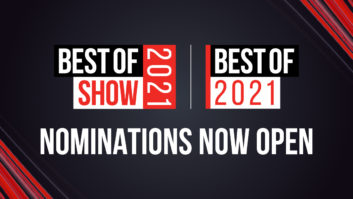In 2020 the broadcast tech industry experienced future shock. In 2021 the convulsions will have barely begun. But contrary to a year in which Coronavirus paralysed industry worldwide, there are numerous reasons to be optimistic and that the months ahead will see us all emerge stronger than ever.
Sports, spectators, spectacle
What was planned as a quiet year for sport will now have the reset Olympics, the UEFA European Football Championship and 43rd Ryder Cup among other titanic international sports, music and entertainment events spearheading a return to with-audience live events.
The safety extended by the distribution of vaccines promises to see crowds return en mass to stadia. The wheels will start to turn into a strong recovery for media and entertainment as a whole especially through the latter half of 2021. Pent up advertising demand will unlock and begin to regenerate cash-starved broadcasters.
Personalisation and gamification
Innovations, delayed by the pandemic will also be unleashed into a year of sport. These technologies include greater 8K acquisition; further adoption of next generation audio and data driven personalisation and commercialisation. The rollout of the 5G network will enable more personalised live event experiences.
Second screen fan activations are just the start of the transition from a broadcaster-directed static view of an event to one in which multiple data and video rich experiences are created alongside the host viewing, giving a full 360 approach. Maximising additional camera angles is one part of this equation while VR and AR will contribute to the video gamification of sport.
Resilience and freedom built-in
A significant change from a year ago is that remote production is now the first-choice and standard operating model for many live event producers and broadcasters. We are seeing organisations begin to bake-in resilience to future shock whether that’s from other waves of Covid-19, a new viral pandemic or indeed anything else that comes out of leftfield and impedes work.
There’s also no-turning the clock back on the proven positive benefits of a work/life balance. Content creators want the freedom to work either in an old school edit bay, in their home office or in a shared workspace. Organisations want the flexibility to scale their workforces and configure workflows at will. Cloud-based remote video collaboration has gone from ‘nice to have’ to necessity.
The cost of sustainability
In 2021 the industry needs to build on the great strides already made in environmental and socially responsible governance. For example, by 2022, video viewing will account for 82 per cent of all internet traffic, according to Cisco’s Visual Networking Index, with internet traffic accounting for well over 1 per cent of global emissions. To counteract this and achieve a reduction in bandwidth, without sacrificing latency, scalability, or quality more efficient video compression must be used. Blackbird’s ultra-efficient codec is already delivering on this vital agenda. Watch for new analysis on Capex savings and energy cost efficiencies this year.
Leapfrog tech pays dividends
More than anything, the M&E industry needs to produce exponentially more content and do so far more cost efficiently. No one doubts that the solution is flexible, remotely distributed enterprise scale workflows – but tomorrow is too late. To get there today and outpace the competition you need a leapfrog technology.
Blackbird is the prime example. For state-of-the-art Cloud video editing and publishing, Blackbird’s unique, lightning fast video editing software and ultra-lightweight technology footprint takes you overnight from a company buried in hardware to one ready for anything the future throws up.






